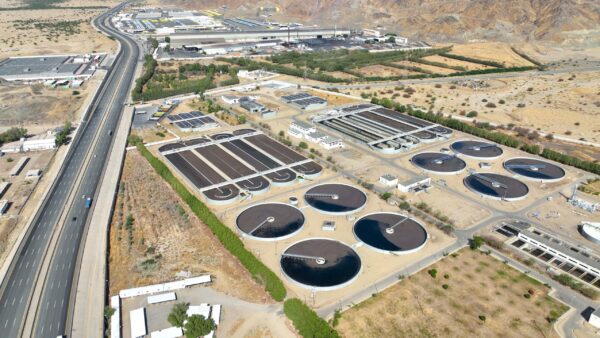

The Middle East has historically been Hill’s strongest region for growth, and, unsurprisingly, Middle East aviation projects represent some of the firm’s largest and most involved assignments. In the past five years alone, Hill has helped to manage more than $40 billion in aviation projects throughout the region, including such mega-projects as the Abu Dhabi Airport Midfield Terminal, Bahrain International Airport Modernization Program, and Muscat International and Salalah Airports Development Projects in Oman, among others.
Although drops in oil prices and currency fluctuations have resulted in relatively flat growth for Middle East air carriers recently, inbound tourism and stopovers continue to drive work in both landside and airside facilities for Gulf Cooperation Council (GCC) regional hubs. In fact, according to Arabian Business, within the next 20 years the Middle East could see an annual rate of growth of close to 4.4%. This translates into a total market size of more than 500 million GCC regional passengers by 2040.
Hill’s Project Director for the Muscat International Airport Development Tarek Abbas, PMP, LEED AP (BD+C), explains that a major driver in the GCC’s aviation growth is due to the changing nature of air travel. “Airports are now operating at or near peak capacity 24-7, 365 days a year,” says Mr. Abbas. “Aviation facilities need to be able to support this kind of pace. And projects, understandably, have to be executed in a way that does not disrupt these existing operations and reflects this reality.”
Mr. Abbas explains that at Muscat, Hill mobilized a staff of some 250 professionals within the project’s first three months. This ability to deliver a large, complete, and talented team right away helped drive the project’s success: the Muscat and Salalah Airports in Oman have won several awards and drawn industry acclaim, most recently winning MEED’s “MegaProject of the Year” award for 2019.
In Abu Dhabi, the new Midfield Terminal Complex alone will accommodate some 20 million annual passengers. Comprising the 700,000 SM Midfield Terminal and related facilities, the project features duty-free retail shops, high-end commercial offerings, international restaurants and cafes, airline hospitality lounges, a transit hotel, and a heritage and culture museum. Operational features include piers that can accommodate up to 65 aircraft, including the Airbus A-380, check-ins capable of handling around 8,500 passengers per hour, and a baggage system designed to process over 19,000 bags per hour with more than 22 km of conveying lines.
Hill Project Director John McKenna says of the Midfield Terminal project, “GCC passengers expect a comfortable and convenient airport experience. Our aviation clients in the Mideast, like the Abu Dhabi Airports Company, understand that failing to consider impacts to the passenger experience when building airports can lead to dissatisfied fliers, as well as frustrated concessionaires and airlines. At Abu Dhabi, the entire team, from the client to each sub, had a passenger and carrier satisfaction mindset. It shows in the finished project: a world-class hub, with cutting-edge amenities and components.
“Hill applies the best practices not only of our airport work to our terminal and other passengerimpacted projects, but also our experience in mixed-used retail and hospitality projects to make certain the passenger experience is exceptional,” says McKenna. “This expertise allows us to present such ideas as reevaluating space locations to take full advantage of the technological advances in passenger processing, flow through ticketing operations, smart curbs to expedite check-in, and common use gates shared by multiple carriers. At Midfield, we worked with contractors to develop the best solutions available for the Abu Dhabi Airports Company, whether for wayfinding, reducing noise, maximizing amenities, or protecting passenger traffic.”
On an even greater scale than the Midfield Terminal project, the $1.2 billion Bahrain Airport Modernization Program (AMP) encompasses two new terminals, associated infrastructure, hotels, retail venues, and other elements. Hill’s services for the project include preparing a project management plan, establishing a general budget, developing a preliminary master schedule, assisting with tender and award, design management, and construction management.
Hill Vice President Uzaif Wasif is helping to lead the AMP. “Next generation airports like Bahrain International are all about realizing greater efficiencies for both landside and airside projects. This means accommodating larger aircraft with additional seats, which means more passengers in the terminals, more vehicles in the rental car facilities, more space for concessions, more cars for monorails, and all the rest.”
Hill’s client, the Ministry of Transportation & Telecommunications/ Bahrain Airport Company (BAC), proposed to build a new terminal building and other facilities to accommodate an annual capacity of 13.5 million passengers to keep pace with the demands of the region’s aviation growth. Hill worked proactively with BAC to take the necessary measures to implement the new AMP strategy.
“The AMP exemplifies the trend to bigger, more integrated airports,” says Mr. Wasif. “To realize BAC’s vision, we emphasized communication, especially during design review, phasing, and, of course, safety and security throughout the project process. The result, as we near completion, is an airport that can support Bahrain’s growth for the long-term.”
As the region continues to experience exponential population growth and corresponding increases in tourism, 24-7 operations, improved passenger experience, and expanded facilities are examples of what air travel in the region is likely to look like in the years ahead.
Share

June 23, 2025 | Articles
Jeffrey Hurley Joins Hill’s Northern California Rail Practice

June 23, 2025 | Articles
Ready, Set, Grow: First VP Chad Koelling Takes Charge of Hill’s Mountain West Region

June 8, 2025 | Articles
PMO in Saudi Arabia: The Holistic Approach to Realizing a National Mega-Portfolio

June 1, 2025 | Articles

May 26, 2025 | Articles

May 12, 2025 | Articles
Keeping Your Water/Wastewater Programs Flowing with Public Relations

April 27, 2025 | Articles
Oiling the Machine: Steps to Successful Permitting on Infrastructure Megaprojects

April 20, 2025 | Articles
Sustainable Scaling: Solutions for Managing Risk on Europe’s Data Center Projects